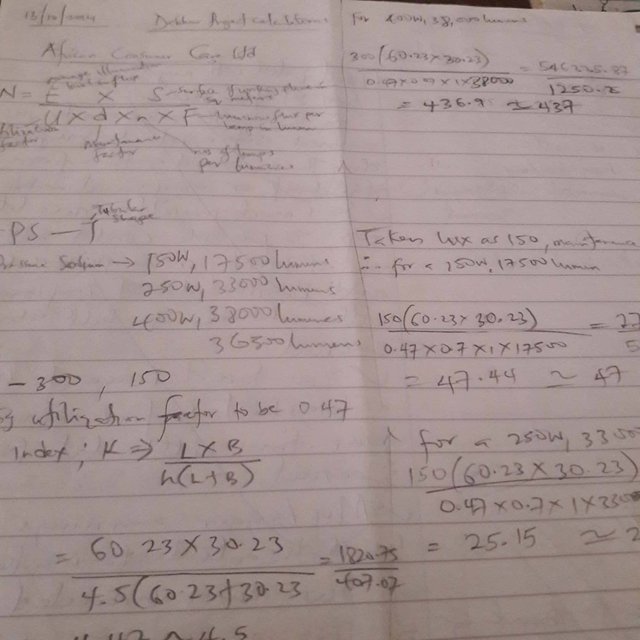WHAT IS GLARE? How lighting affects Moods and work output/performance(Video Below)
Light source creates one of the most appropriate ambiance and mood, that is one of my very first lessons as a Trainee Electrical Engineer few years back. Though i majored in Electronics and Telecommunication systems, but that didn't stop me from working in a construction company for almost a year. I worked as an Entry level engineer under a lady certified engineer in the Mechanical and Electrical Department(M&E), and boy; it was helluva ride!
One of my tasks is doing Photometric Analysis- Simulated lighting layout and designs for any building projects, be it commercial or domestic construction projects. As a junior engineer i was faced with mountains of calculations for Light fittings and how it suits the occupants of those building, so the subject of my blog today is to create awareness on the effect of lighting of your homes and offices/workplaces on your moods and performances/Work outputs.
GLARE
Glare is difficulty seeing in the presence of bright light such as direct or reflected sunlight or artificial light such as car headlamps at night. Glare is caused by a significant ratio of luminance between the task (that which is being looked at) and the glare source....Wiki
It is a visual impression created by the presence of illuminated area in the field of view. It could cause tiredness, errors, and some injuries to the eye, it always makes affected individuals feel uncomfortable, but might necessarily not cause eye strain every-time.
As defined by wikipedia, examples is causes of Glare can be Sun rays, poor lighting layouts in Building and offices, A computer screen or Television screen, a reflection from a distance metallic objects and headlights from cars which affects drivers. Because of this, some cars include mirrors with automatic anti-glare functions. Some offices deploy anti-glare glasses for workplaces, some homes use anti-glare glasses for designs etc. Bottom line is that, a zero-tolerance to Glare in work environments and home sis advisable . Preventing it is important from work safety point of view and the several means of eliminating it includes;
Correct placement of Luminaries(Light fittings).
Using Specified Luminaries.
Adequate Photo-metric studies.
Professional M&E consultants is advised.
PREVENTING GLARE FROM AN M&E POINT OF VIEW
From an Electrical Engineer perspective, achieving a Glare free environment depends solely on the following factors; Luminous Flux, Luminous Intensity, Luminance, Maximum Luminary Spacing, Working Plane, Utilization factor and Average illumination level. I shall briefly explain each below;
- Luminous Flux (Φv): The total light quantity emitted by a light source, it is a measure of perceived power of light with it's units in Lumen, lm.
- Luminous Intensity (I= Φ/ω): This is the Luminous Flux emitted in a given direction (ω= Solid Δ) and it's unit is Candela, cd.
- Luminance L=I/A: Luminous intensity per square meter of visible surface A. Unit is Candela Per Square Meter (Cd/m^2)
- Lumen Method of Calculating illumination for Interior Lighting: To create an average illuminance Level (E) on the working plane by a regular pattern of ceiling of ceiling /roof luminaries, the necessary numbers of luminaries is calculated as;
N=E×S/U×d×n×F
E- Average illuminance level in LUX
S- Surface of Working Plane in M^2
U- Utilization Factor
d- Maintenance or Depreciation factor
n- numbers of lamps per luminaire.
F- Luminous flux per lamp in Lumen

How it all looks on paper- A rough calculation made by me with this formula in 2014
- Utilization Factor: Depends on the following- Room Index, Reflectance, Correction factor, Maintenance Factor.
- Working Plane(s): 0.75 to 0.80 meters for Offices spaces and 1.00 meters for Working Areas.
- Maximum Spacing of Light Fittings_: Max spacing between the luminaries in order to obtain a uniformity of at least 70% is given by "e/h" ration;
e = center distance between two luminaries
**h **= distance between luminaire and working plane.
There is a value for each Luminaire ration in The Photometric Data Table as designed by different Light fittings manufacturing companies but with an International Standard Rules.
- Average Illumination Level: This is the summary of Recommended Standard illumination levels for various interiors and tasks(Work).
| LUX | AREA/APPLICATIONS |
|---|---|
| 100 | Corridors, Circulation Areas. |
| 150 | Stockrooms, Stairs, Stores. |
| 300 | Lecture Theaters, Classrooms, Rough Work- Heavy Machinery assembly. |
| 500 | Libraries, General Offices, Laboratory, Medium Work- Engine assembly. |
| 750 | Drawing Offices, Fine Works- Electronic and office machinery assembly. |
| 1000 | Precision proofing, Etching, Retouching. |
| 1500 | Very fine Work: Instrument assembly. |
Glare can be grouped into; Discomfort glare and Disability glare.
Discomfort glare results in an instinctive desire to look away from a bright light source or difficulty in seeing a task.
Disability glare impairs the vision of objects without necessarily causing discomfort. An example is when driving towards sunset. Disability glare is often caused by the inter-reflection of light within the eyeball, reducing the contrast between task and glare source to the point where the task cannot be distinguished. When glare is so intense that vision is completely impaired, it is sometimes called dazzle!
To know more about Glare in vision, watch the short video below:
Video Credit; Philip Lighting.
References
e-lights Photometric Distribution
FOLLOW-UPVOTE-RESTEEM AND MAYBE DROP A SUPPORTING OR CONTRARY COMMENT.....It's your friendly Neighbor @oluwoleolaide for Steem-Lagos-Nigeria-Africa-World!

Badge courtesy of @jodi.pamungka Animated Footer by @rituparnaghosh



What is a Slurry?
https://steemit.com/technology/@splatterhaus/ask-slurry-your-own-personal-drunken-redneck-slob-bot-that-will-answer-your-questions-and-make-life-better-now-on-android-os
You know this doesn't have anything to do with the post right? And it is considered as spam yeah?... Not cool mate
thank you for giving a details about glare
You are welcome...
Nice delivery boss
Gracias bro!
This was really informative. Does glare have any permanent negative effect on eyes?
As a matter of fact, No.
Reason is, it make you uncomfortable therefore you tend to leave that position or do something about it. But for babies, it is bad as they are helpless and might cause Cataract just like staring at the Sun.
Okay.. Thank you.
Very welcome, will visit your blog soon.
I look forward to that.😊
Hello @oluwoleolaide
I never knew the way houses and offices are illuminated has an effect on occupants mood and individual's ability to carry out assigned task.
Indeed, we continue to learn every day. This is quite educative.
@eurogee
Yes bro, when i still work as a M&E that was my job, doing Photometric Studies for different Building Construction...
Thanks for this interesting post. One of the most important protections should be from natural-sun glare conflicting with the computer screen.
It's important to note that it's not okay to ignore the discomfort associated with room lighting when working at the computer.
I say, do whatever it takes, silly as it may appear, to protect your eyes from harm ;+)!
Peace.
You are very right ma'am, i love this input....Sun-Glare seems to be most common as Technology had eliminated the Lighting and computer screen Glare, the new model of laptops has Anti-Glare Screens.
Yes, the anti-glare screens are helpful, as well as adjusting the screen lighting; but, protecting eyes from sun when working on the pc is critical.
Again, thanks!
Peace.
Cool lecture
Lol, that was the Engineer part of me...